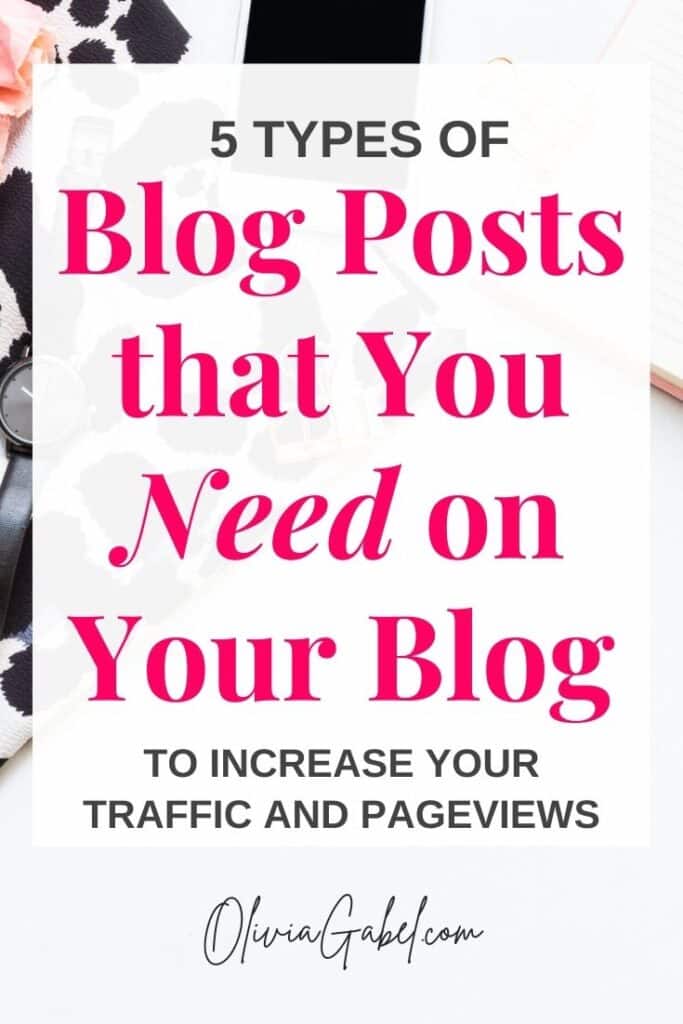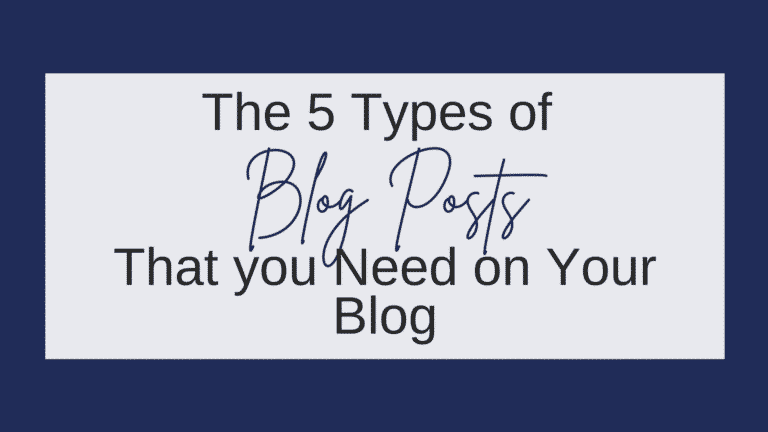The recipe for success when it comes to blogging as a business is simple. Win returning visitors, so you can convert clicks into subscribers who become long term readers and customers.
How do you do that?
It’s easy! Just create irresistible content that people want to read.
Easier said than done, right?
Actually, it is easy.
You just need to know the types of blog posts people want to read, so they read and then share them with all their friends and neighbors.
Here are five types of blog posts that your blog needs today so you can grow your audience and increase your page views fast.

1. Long-form Blog Posts
Long-form posts are great because you have the opportunity to show off your value and credibility in a single blog post.
Simply by writing more thoughtful content, you will organically (i.e., for free!) grow your audience faster because long-form posts get more shares and rank better in google.
People love to read long-form posts for many reasons. One of the main reasons is that no one wants to click around to a ton of different blog posts to get all the information they are looking for.
What’s a long form-blog post?
The definition of a long-form post varies depending on who you ask, but based on the statistics below, we will say that a long-form blog post is any post that is greater than 1,500 words.
If you are willing to spend the extra time to get to 2,000 words, even better!
Wondering if it’s really worth it to spend time on long-form posts?
and
Longer form content gets more shares because it has more researched content that provides usable value.
On top of that, the algorithm in search engines like Google tend to find long-form content more relevant, which means that your post is likely going to be returned higher in the results than a similar shorter length post.
*Bonus Tip: It’s always important to focus on SEO and keep topics relevant to your ideal audience.
The biggest downside of long-form posts for many bloggers is that they take longer.
But I promise it’s worth the extra few hundred words in the long run because long-form posts can be re-used and re-purposed easily. For example, you could turn a series of long posts into an ebook and cash in (literally) on that passive income. (#hustle)
If long-form posts sound daunting, don’t worry! You don’t need to do long-form 1,500 – 5,000-word posts for every single blog post.
You can use long-forms posts strategically by choosing high-quality and enticing topics that solve a popular problem for your audience.
Try it out!
When coming up with ideas for long-form content, try to use what has performed well in the past.
Do you have a shorter post about Instagram that gets tons of clicks? Why not do a deep on that topic?
Is there an experience that you can immerse your readers in or a topic that you can “teach” as a single blog post?
Instead of thinking about long-form posts as intimidating, think of them as giving your brilliant content as much room as it needs to shine.
*Side-note, trying to get word count just to get word count causes a loss of credibility. Always aim to provide insightful content that provides value by solving a problem.
2. Tips, Tricks, & How to’s Posts
People love to click on content that has phrases like, “How to,” “Top Tips,” and “Best Hacks.”
Why?
To make their life better.
Do you ever take the time to notice what you are usually typing in google or the types of Pins you click on?
You are trying to learn something or find practical information to make your life easier or better in some way.
Just this morning, I asked my husband to google how to make the Starbucks Pumpkin Cold Brew foam. I want to know how to make that deliciousness in my own kitchen!
Tips, tricks, and how to’s are some of the best types of blog content.
They are not only fun to write, but people love to read them, and you can establish credibility and build trust with your audience while making their life better.
Plus, amazing free content makes more money.
If you sell digital products, like e-courses, and you don’t want to do how-to’s because you are worried that no one will want to buy anything from you if you give too much away for free.
Don’t be.
First, it’s extremely unlikely that a couple of How to blog posts will give away your entire business strategy or course. I can guarantee they won’t.
Secondly, by spilling the “secret sauce,” people will want to buy from you even more. If every tip is actionable and insanely valuable for your audience, they will keep coming back for more content.
The more value you give away for free, the higher the perceived value becomes of what people can buy from you.
Try it out!
Choose 5 -10 of your favorite tips, tricks, hacks, and write a tidbit about how and why they work. Or do a single post dedicated to a valuable How to.
Here are some examples:
Top 10 Content Calendar Tips
Best Blogging strategies for beginners
What’s a digital marketing strategy, and does my business need one?
How to create click-worthy Pinterest pins
Instagram Hacks that Grow your Business
3. Success stories, Inspiring and Motivational Blog Posts
You know the feeling you get when you read an inspiring story or a motivational quote that you can relate to?
A single quote can lift your spirits and inspire action. Stories can move you to tears, comfort you, and push you to keep going.
And you know what? Other people love those feelings too.
Sharing inspiring and motivational content that is relevant to your audience builds an emotional connection with them.
Don’t believe me?
There are entire websites and businesses dedicated to sharing these types of stories. Look at John Krasinski’s Some Good News.
He started his own YouTube mini-series to spread good news and inspiration in the middle of the global COVID lockdown. It has 2.58M subscribers (9/15/20), and CBS bought it.

Try it out!
As a digital entrepreneur, you have a story!
Not every type of success story has to bring people to tears by pulling at their heartstrings to motivate and inspire them.
People love success stories. If you see something that reads, “Brand new blogger got 10 million clicks in the first week.” You are going to be click.
Were you working the regular 9-5 corporate life and decided to pursue your passion of starting a side business that is now your full-time job. That’s incredible!
Did you figure out how to get a ton of Instagram followers, or make multiple Pinterest pins that went viral, brilliant!
People want to feel connected to you and your brand, so it’s great to share your story and other motivational pieces.
Here is one advisory from Neil Patel on this type of content:
“Always think from the perspective of your readers. If your story is irrelevant to your audience and doesn’t add any value, then you’re boasting. And no one likes a self-serving snob.”
4. Lists Posts aka Listicles
Like How to and Tips and tricks posts, people love content that provides them a ton of value in an easy to digest way.
Creating a great list post, or a listicle, saves people time, which is invaluable. Who has time to meander around the internet looking for things?
Lists are a fantastic tool that can help organize content, and they make easy and clickable headlines.
Did you know that 36% of readers prefer list-based headlines?
When you see titles like the ones below, aren’t you dying to know more?
- 10 easy ways to grow your email list
- 25 steps to start a side-hustle in a weekend
- 100 blog post ideas
- 15 of the best marketing tools to grow your business
- Become a millionaire in less than 10 steps
Try it out!
Formatting is always important when creating content. This is especially true for lists posts.
Be sure to include lots of white space, meaning no walls of text, and use bold headings so people can quickly skim it to find what they are looking for fast.
When expanding on your list items, the descriptions can be brief, but there should usually be some type of description.
When you are trying to come up with an idea for a list, try to think of information that you want all in one place. It’s also a good idea to make sure you thoroughly covered the possible options in the list.
For example, would you rather click on “10 can’t resist the click blog post ideas” or “50 can’t resist the click blog post ideas”?
You want more ideas.
5. Blog Post Series
You’ve heard how consistency is key when it comes to blogging or any kind of content marketing. That’s because putting out great content regularly is the foundation to build a successful and scalable business while keeping your audience engaged.
But sometimes, while building a business, you get to the end of the content calendar (or you don’t have one, learn how to change that here), and you have no more blog ideas, but you need a new blog post ASAP.
Try a blog series.
Series posts are when you take one idea and turn it into multiple blog posts for an in-depth guide or look into that topic.
This is especially helpful when you are feeling overwhelmed trying to come up with new content. When you choose to do a series, you automatically end up with multiple blog post ideas to write.
If you do a series that you can break up into 4 or 5 posts and publish once a week, you have content for a month!
Plus, a series provides the opportunity to bring your audience on a fun journey with you, where they can get to learn a lot about a single topic.
For example, you may have seen series like “The Basics to Grow your Pinterest Following,” “How to build a Client Winning Website,” or even “How to make the world’s best chocolate chip cookies.”
Like long-form posts, a series is easily re-usable, and if you choose the right topic, it will be relevant for years! How great is that?!
Try it out!
You may already have an idea for your series, but if not, you can use trusty Pinterest to find an idea. Use the search bar to find topics in the Pinterest type ahead or see which pins show up at the top of the search results.
Plan for your series to be 3 – 5 separate, but individually valuable, posts for your audience.
Each post should be able to stand on its own. So if someone didn’t read all of them, the current one would still make sense and be helpful.
Try to think of a blog series like a 30-minute comedy on TV. You can watch a single episode and still laugh even if you missed the last episode.
Bonus tip! Don’t forget a call to action at the end of your series posts.
- Link to the previous or next series posts with ‘Additional Reading.’
- Generate new subscribers by asking people to subscribe to “Be the first to know!” about the next post in your amazing series via email.
Add These Posts to Your Blog Today!
Building a successful blog takes time, but these five blog posts will help your blog grow and keep your audience engaged with new and exciting content.
You can experiment to find out which type of post your audience likes the best and then build more of those into your content calendar.
Of course, you also need to promote your content on social media so people can find you! So check out how to create click-worthy Pinterest pins here.



